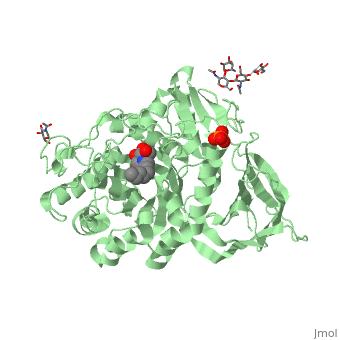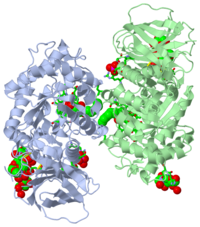ACID-BETA-GLUCOSIDASE WITH N-NONYL-DEOXYNOJIRIMYCIN (2v3e)
(see also Treatment of Gaucher disease, 2v3d, and 2v3f)
Publication Abstract from PubMed
Gaucher disease is caused by mutations in the gene encoding acid beta-glucosidase (GlcCerase), resulting in glucosylceramide (GlcCer) accumulation. The only currently available orally administered treatment for Gaucher disease is N-butyl-deoxynojirimycin (Zavesca, NB-DNJ), which partially inhibits GlcCer synthesis, thus reducing levels of GlcCer accumulation. NB-DNJ also acts as a chemical chaperone for GlcCerase, although at a different concentration than that required to completely inhibit GlcCer synthesis. We now report the crystal structures, at 2A resolution, of complexes of NB-DNJ and N-nonyl-deoxynojirimycin (NN-DNJ) with recombinant human GlcCerase, expressed in cultured plant cells. Both inhibitors bind at the active site of GlcCerase, with the imino sugar moiety making hydrogen bonds to side chains of active site residues. The alkyl chains of NB-DNJ and NN-DNJ are oriented toward the entrance of the active site where they undergo hydrophobic interactions. Based on these structures, we make a number of predictions concerning (i) involvement of loops adjacent to the active site in the catalytic process, (ii) the nature of nucleophilic attack by Glu-340, and (iii) the role of a conserved water molecule located in a solvent cavity adjacent to the active site. Together, these results have significance for understanding the mechanism of action of GlcCerase and the mode of GlcCerase chaperoning by imino sugars.
Crystal structures of complexes of N-butyl- and N-nonyl-deoxynojirimycin bound to acid beta-glucosidase: insights into the mechanism of chemical chaperone action in Gaucher disease., Brumshtein B, Greenblatt HM, Butters TD, Shaaltiel Y, Aviezer D, Silman I, Futerman AH, Sussman JL, J Biol Chem. 2007 Sep 28;282(39):29052-8. Epub 2007 Jul 31. PMID:17666401
From MEDLINE®/PubMed®, a database of the U.S. National Library of Medicine.
of the native human acid β-glucosidase, expressed in cultured plant cells (pGlcCerase, 2v3f) on those of N-butyl-deoxynojirimycin/pGlcCerase (2v3d), N-nonyl-deoxynojirimycin/pGlcCerase (2v3e), and isofagomine/deglycosylated Cerezyme (IFG/DG-Cerezyme, 2nsx) reveals significant structural identity, neither of these ligands causes structural changes upon binding to the enzyme. The imino sugar of N-butyl-deoxynojirimycin forms 7 hydrogen bonds and also makes several hydrophobic interactions with side chains of active site residues (2v3d). The crystal structure of pGlcCerase in complex with N-nonyl-deoxynojirimycin (2v3e) is very similar to that of NB-DNJ/pGlcCerase. The exception is that longer chain of NN-DNJ interacts with 2 additional residues Leu241 (labeled lime) and Leu314 of symmetrically related monomer (not shown). Comparison of the structures of NB-DNJ/pGlcCerase (2v3d) and NN-DNJ/pGlcCerase (2v3e) with that of (2nsx) shows that the pyranose-like ring forms a same number of hydrogen bonds with the enzyme in all three cases (2v3d, 2v3e, and 2nsx).
About this Structure
2V3E is a 2 chains structure of sequences from Homo sapiens. Full crystallographic information is available from OCA.


